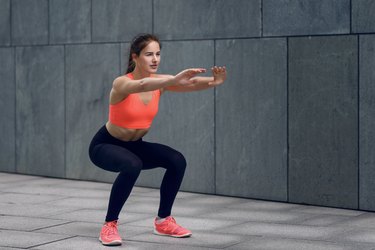
Squats and seated leg press exercises both go a long way toward strengthening and toning the quadriceps. Though both are different in execution and where they can be performed, both squats and seated-leg presses are multi-joint exercises that engage muscles at the hip, knee and ankle joints.
Both exercises are effective for developing strength, size and definition in the quadriceps, hamstrings and gluteal muscles. Strong leg muscles increase coordination, improve performance and boost your metabolism.
Video of the Day
Video of the Day
Incorporate both into your leg workout or choose the one that best suits your purpose — just make sure to perform either movement safely to avoid injury.
Related Reading
Squats and Functional Training
Bodybuilders, power lifters and workout enthusiasts alike perform a number of variations of the squat to build muscle, burn calories and tone. For optimum muscle building, the squat is performed using a barbell across the shoulders, although dumbbells or resistance bands can also be used. Many simply do squats with body weight and no added resistance.
No matter your choice in weight variation, squats are performed by standing with your feet shoulder-width apart, moving your hips backward, and bending your knees as if you are about to sit on a chair and keeping them in line with your feet throughout, says ExRx.net. Keep your chest lifted and arch your lower back slightly. Keep your abdominal muscles engaged. Stop when your thighs are parallel to the floor, then slowly return to start.
Squats help with functional training — that is, it helps with the moves that you do every day. It also works your core muscles, along with your legs, and works every muscle in the legs, rather than just a few.
Read more: 15 New Squat Variations for Every Fitness Level
Seated Leg Press
One seated leg press machine benefit is that you can isolate the muscles you want to train, says Coach. In a seated leg press, only your lower body is engaged, and your back has more protection from injury.
Start in a seated position with your feet on a platform. Release the levers attached to the weight plates, allowing the weight to come down, then slowly extend your legs without locking your knee at the top of the movement, according to the American Council on Exercise. Keep your back flat and abs engaged, then pause and slowly bend your legs at the knees to return to start.
If you're a beginner in strength-training, leg presses might be the way to go. They offer assistance in proper form and allow you to train your leg muscles without as much risk of injury.
Read more: Leg Press Vs. Leg Extension
Leg Press vs. Squat
Although both exercises work the quads effectively, a squat engages your gluteus maximus more effectively as a hip extensor. Your hamstrings are also engaged in both exercises, but to a greater extent in a squat.
If you're holding dumbbells or a barbell, squats also involve your shoulders, back and arms to stabilize your upper body and balance the weight, making squats a whole-body exercise.
The seated leg press provides far more support for your back and core muscles, allowing you to focus your full attention on your leg work. Good form is important in both exercises, but poorly performed squats pose a greater potential for injury.